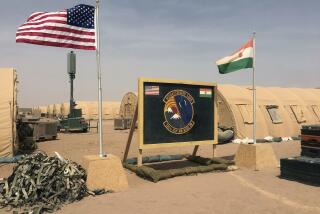A Secretive Existence for Lone ‘Base’ in Gulf Region : U.S. Post in Bahrain Kept Under Wraps
- Share via
JUFAIR, Bahrain — An unmarked road lined with ancient palm trees snakes gently toward the sea. Without warning, huge concrete cubes painted canary-yellow block the roadway, and a stenciled sign orders with understated menace: “Dim Your Headlights for the Sentry.”
Behind the sentry box, the white roofs of huge warehouses loom over the greenery. An orange crane for loading and unloading cargo ships stands idle on the quay.
Behind a chicken-wire fence, comfortable in its anonymity, stands the Administrative Support Unit, its very name an exercise in vagueness. For the ASU, as it is known throughout this island, is the only U.S. military facility in the Persian Gulf region--a fact that both the Bahrain government and the U.S. Navy, in the jargon of the Pentagon, are keen to “downplay.”
With the increase in regional tension after the American decision to provide escorts for Kuwaiti ships in the gulf, the United States has increased the number of ships in its Mideast Force from six to 10, with perhaps an equal number just outside the Persian Gulf in the Gulf of Oman.
Keeping the growing fleet, and its 20,000 sailors, supplied with everything from toilet paper to groceries is a logistical nightmare, and the burden falls increasingly on the staff of the ASU.
“The two things that strike me about the ASU,” said a military officer who works there, “are that they are the hardest-working people I have ever encountered, and it is by far the ugliest base I have ever seen.”
Mention of the word base brings immediate disclaimers from U.S. and Bahraini officials. In fact, the ASU ceased to be an official U.S. base in 1974. It is now rented commercially from the Bahraini government for $2 million a year.
“We don’t want to give the impression that we are part of this war, or part of the convoy operation,” said Tarik Moayyid, the Bahraini minister of information. “We feel confident that since we managed to stay out of the war for so long, we will manage to keep out of it.”
Countries such as Kuwait, which are benefiting directly from the U.S. presence in the gulf, have denied the United States facilities similar to the one in Bahrain. At one point, Kuwait refused even to permit American warships to enter its territorial waters.
The Bahrainis have traditionally been close to the American military and to the British, who used the ASU as a base before the Americans.
“The Americans were told that they could do whatever they wanted in Bahrain, as long as they remained incognito,” a Bahraini journalist said.
Spread over seven acres, the ASU provides logistical support to the ships of the Mideast Force by warehousing supplies and fuel oil. Munitions have never been stored there, according to a Western diplomat.
The facility is also the headquarters of Rear Adm. Harold J. Bernsen, commander of the Mideast Force.
In addition to supplying the fleet, the ASU serves as a conduit for military personnel traveling to and from ships in the gulf. Apart from the shore facility, the ASU officially includes a hangar at the Bahrain airport, where Air Force C-5A and C-140 cargo planes bring in supplies. There is a weekly passenger flight as well. Men are taken out to ships in the gulf by two “Desert Duck” helicopters.
There are about 150 people assigned to the facility, the majority of them civilians. There is staff housing, a post office, a swimming pool, a snack bar and a small commissary.
Bahrain also provides the only outlet for sailors on duty in the gulf when their ships berth at the ASU. But access is limited, and shore leave is strictly controlled.
According to one official, liberty visits are confined to groups of 100 sailors at a time, and they are prohibited from wearing uniforms ashore.
Bahrain has bars and discos. The sailors must return to their ships by early evening, although hotels near the ASU sponsor an occasional “crew night.”
Normally, ships in the Mideast Force are based in Florida and go to sea for a six-month tour of duty--one month for the trip out, four months on station and one month to return.
“Even though they don’t wear uniforms, you can always tell the sailors,” a resident said. “They’re the ones with T-shirts, crew cuts and suntans.”
More to Read
Sign up for Essential California
The most important California stories and recommendations in your inbox every morning.
You may occasionally receive promotional content from the Los Angeles Times.













